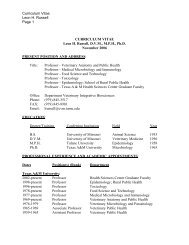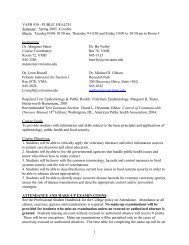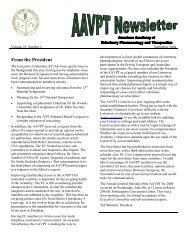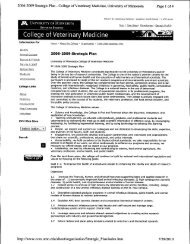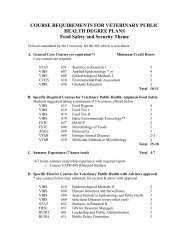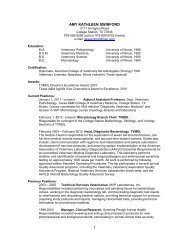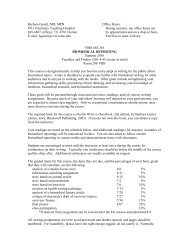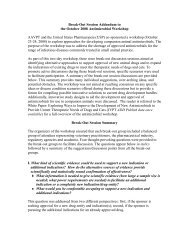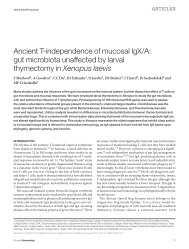Disaster - College of Veterinary Medicine - Texas A&M University
Disaster - College of Veterinary Medicine - Texas A&M University
Disaster - College of Veterinary Medicine - Texas A&M University
You also want an ePaper? Increase the reach of your titles
YUMPU automatically turns print PDFs into web optimized ePapers that Google loves.
I“I remember seeing an ad on television <strong>of</strong> a female scientist<br />
holding a microscope,” laughed Jacobs. “Once I saw that,<br />
I knew I needed to become a scientist so that I could have a<br />
microscope!”<br />
Fortunately, Krystyna Jacobs and research assistant pr<strong>of</strong>essor,<br />
Dr. Gloria Conover, share the same passion and enthusiasm<br />
for science.<br />
“Research is so much fun. It’s like putting a giant puzzletogether<br />
based on experimental evidence for the scientific<br />
community,” comments Conover. “Research definitely takes<br />
a great deal <strong>of</strong> work and patience, it may take a week to get<br />
even one result from an experiment, but it’s all worth the<br />
effort when you are the first person to see the result. It can<br />
also make a great impact on the diagnosis and treatment <strong>of</strong><br />
disease.”<br />
Jacobs is a member <strong>of</strong> the prestigious Undergraduate Research<br />
Scholars program and presented a project in the Molecular<br />
Biology & Microbiology category during Student Research<br />
Week. With the assistaince <strong>of</strong> Dr. Gloria Conover and<br />
prospective graduate student Samaneh Karami, Jacobs won<br />
first place with her<br />
poster presentation.<br />
Jacobs has been<br />
conducting research<br />
for two and a half<br />
years, and has been<br />
working with Conover<br />
since September 2009.<br />
Conover has convinced<br />
Jacobs to write<br />
a thesis for the Undergraduate<br />
Research<br />
Scholars Program.<br />
The program gives<br />
undergraduate honor<br />
students the opportunity<br />
to showcase<br />
their hard work and<br />
research by writing<br />
a thesis at the end <strong>of</strong><br />
their senior year.<br />
“Krystyna has put a<br />
huge amount <strong>of</strong> time<br />
and dedication into<br />
her thesis so far,” said<br />
Conover. “The Undergraduate<br />
Research<br />
Scholars program requires a minimum <strong>of</strong> 12 hours a week,<br />
and she puts in at least 16 to 20 during that timeframe,<br />
and is willing to work on the weekends if needed for the<br />
experiments.”<br />
Student presentations are hosted every three weeks. This<br />
gives the students a chance to practice presenting their<br />
research, as well as making sure that what they have found is<br />
consistent with what other researchers have found, and that<br />
the information makes sense to the audience.<br />
Jacobs’ thesis will describe the research in muscle disease<br />
that she and Conover have conducted over the past two<br />
semesters. The project, entitled “The Effect <strong>of</strong> a Nemaline-<br />
Myopathy Nebulin on Desmin Associated to Sarcomeres,”<br />
was the subject <strong>of</strong> the winning poster presentation. Their research,<br />
which is still in the beginning stages, is on investigating<br />
the molecular mechanisms underlying muscle diseases.<br />
The focus <strong>of</strong> Jacobs’ thesis is on the relationship between<br />
the intermediate filament protein desmin, and nebulin, and<br />
the effect <strong>of</strong> this association in nemaline-myopathy, the most<br />
common non-dystrophic skeletal myopathy in humans.<br />
“Our main research interest in the laboratory focuses<br />
on the role <strong>of</strong> intermediate filament proteins in disease,”<br />
said Conover. “Our goal is to decipher the functional significance<br />
<strong>of</strong> the association <strong>of</strong> the filament desmin to the<br />
giant thin filament nebulin, at the sarcomeric Z-discs, and<br />
its relation to muscle disease. Mutations in nebulin cause<br />
nemaline-myopathy; a debilitating genetic muscle disease<br />
that affects children and adults alike. Interestingly, there are<br />
reports in the literature that describe this condition in cats.”<br />
Conover’s previous research showed that nebulin has high<br />
affinity binding to desmin. However, little is known about<br />
the involvement <strong>of</strong> this interaction in nemaline-myophathy.<br />
“We still are searching for the effect that nebulin has on<br />
certain mutations,” said Jacobs. “We do know that the mutation<br />
has an effect, we just need to figure out the mildness or<br />
severity <strong>of</strong> that effect on the binding.”<br />
Jacobs has many aspirations. Upon her August graduation<br />
from <strong>Texas</strong> A&M with a degree in Biomedical Sciences with<br />
her extensive research<br />
experience behind<br />
her, she will apply to<br />
medical school for the<br />
fall <strong>of</strong> 2011. This will<br />
give her a year-long<br />
break from school<br />
and will also allow her<br />
the chance to work<br />
with Conover on the<br />
nemaline-myopathy<br />
research.<br />
“I enjoy research<br />
because you get to<br />
be right on the edge<br />
<strong>of</strong> new discoveries,”<br />
said Jacobs. “As a researcher<br />
in Conover’s<br />
lab, I have learned<br />
the value <strong>of</strong> patience.<br />
Research does not<br />
happen overnight.<br />
It takes days, weeks,<br />
sometimes months to<br />
produce viable results<br />
that help convey new<br />
information. It is a<br />
great feeling when you have results that no one has ever seen<br />
or produced before. Knowing that my research helps others<br />
to better understand the ‘why’ <strong>of</strong> nemaline-myopathy gives<br />
me a feeling <strong>of</strong> accomplishment.”<br />
Conover feels that it is important to give Biomedical Science<br />
undergraduate students the opportunity to conduct<br />
research, right here at the <strong>Texas</strong> A&M <strong>College</strong> <strong>of</strong> <strong>Veterinary</strong><br />
<strong>Medicine</strong> & Biomedical Sciences.<br />
“I feel strongly that early experiences for undergraduate<br />
research are essential for the advancement <strong>of</strong> the biomedical<br />
sciences, because I believe that if a student experiences the<br />
joy <strong>of</strong> the discovery process it will enhance and expand his<br />
or her career choices,” said Conover. “I like to foster the innate<br />
creativity <strong>of</strong> our students in our research, and I also like<br />
to mentor students about the many ways they can contribute<br />
to science and pursue scientific careers at a pr<strong>of</strong>essional<br />
level.”<br />
“I remember seeing an ad on<br />
television <strong>of</strong> a female scientist<br />
holding a microscope,” laughed<br />
Jacobs. “Once I saw that, I knew<br />
I needed to become a scientist so<br />
that I could have a microscope!”<br />
CVM Today • Summer 2010 • 17




